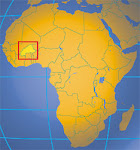A number of events/trainings were held that reaffirmed my love of language learning and working with teachers (a few pictures below):
For ATES' English Language Day, Michelle and I were asked to conduct a training on Instructional and Management Strategies in Mixed-Ability Classrooms.
One of my last meetings with one of my favorite Dakar English teacher cells. They decided to break out into song, singing John Legend's "All Of Me." Hahaha!
I was asked to help coach and judge a competition for MYouth Mobile Camp Senegal. Six teams were chosen to participate after vetting of their applications, and they were asked to pitch their mobile app (on education, commerce, environment, health, etc.) to a group of judges in both French and English. These were some incredible apps! Ultimately, an education app won, and they were given the opportunity to compete in another global competition.
ATES also hosted the Dakar Students' Day, where Michelle and I helped out with the Spelling Bee. There was so much buzz around this whole day, and it was great to work with students!
One of the biggest projects we at Senegal's Ministry of Education's Bureau d'Anglais (Office of English Teaching) wanted to accomplish was a Central Region Teacher Training. Ngouye, my boss, identified a couple of areas of Senegal that requested and wanted more professional development training due to a lack of resources, etc. With generous help from the U.S. Embassy, we were able to plan and execute this Central Region Teacher Training with much success!
For a week, we traveled to four specific areas/towns: Diourbel, Kaolack, Kaffrine, and Fatick. The teachers in each of these towns/regions requested different professional development themes and we wanted to make sure that we were able to understand their teaching context, address them, and provide appropriate strategies that they can implement directly in their classrooms/in their professional careers.
Some of the topics/themes addressed were: Project-Based Learning; Strategies in Preparing Students for the BFEM National Exam; Incorporating Culture in English Language Teaching; Teaching Grammar Communicatively; and Teaching Vocabulary Communicatively.
Because we were heading to the central region of Senegal, it was very hot and the schedule was quite grueling, but we kept pushing through. In total, we worked with about 120+ English teachers who effectively disseminated the information they gained with their respective English teaching cells. As is customary in West Africa, Certificates of Participation were given as a token of our appreciation for their attendance and participation -- and hopefully to encourage them to use these strategies soon!
I will say that I was impressed with the caliber of English teachers, their passion and drive, and their active participation. I almost wish I recorded all of the discussions to be used in some other way for future professional development trainings! But this kind of zeal motivates me...and makes me wonder if I should come back again soon in another capacity...
Ngouye and I, stamping and signing the various Certificates of Participation for our 120+ English teachers!
Our first training in Diourbel.
We were lucky enough to stay Adjana Hotel, a new complex in Kaolack. The rooms were absolutely beautiful! A nice little break from a busy day of teacher training.
Ngouye and I about to start our training in Kaolack.
Some wonderful participants in Kaolack!
Kaffrine had some great discussions on incorporating culture in English language teaching...and I forgot to mention that the U.S. Embassy provided us with prizes to give teachers. We used them at the end for mini-quizzes to see if teachers were paying attention during our presentations, haha!
Our last group in Fatick was very dynamic and had some of the best discussions. If only we were there longer to keep it going!
Saying farewell is never easy, but it eventually needed to be done at the Ministry of Education, my work home for the majority of my Fulbright fellowship.
Since formalities are essential, I had to say farewell to Mr. Joseph Pierre Ndiaye, Director of the Cabinet of the Ministry of Education (second in line after the Minister of Education). A very funny and intelligent man!
As I had mentioned before, my last thing was to create a sort of institutional memory piece so that future Fulbright ETAs can continue the work and collaboration with the Ministry of Education's Office of English Teaching -- and also so that we're not constantly reinventing the wheel. For my last few weeks, I worked on creating and compiling a Fulbright ETA Portfolio: Professional Development Presentations & Other English Language Activities. It felt like quite the accomplishment and great to put this all together!


























































